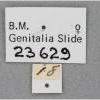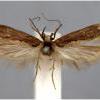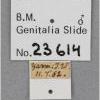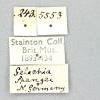35.121 Scrobipalpa stangei (Hering, 1889)
Status and Distribution
Extinct. Formerly present at Yarmouth, Isle of Wight in July 1882 but searches, specifically in 1985 and 1986, failed to find any signs of the moth. The two specimens with data are from the Bankes collection and are in the NHM London. Further specimens without data are also in the British collection at the Museum and Klaus Sattler has very kindly provided the following information on these - Whittle coll., ex Tutt: 2 males, 1 female and 3 unsexed specimens, all without data labels but some with individual numbers. It is not known what those numbers signify.
Provisional map
Pupa
Set Specimens
Foodplant and Larval Feeding Signs
Foodplant unknown in Britain. In Europe feeds predominantly on Triglochin maritimum (sea arrowgrass), see the British distribution map for this species, and has also been observed on T. palustris (marsh arrowgrass).
In Europe, in Spring, the larva produces a broad translucent leaf-mine but also feeds in the shoots, stem or roots. The larva mines flower stalks and leaves; in the attacked leaves a part of the leaf droops and forms an acute angle with the rest of the leaf; frass is deposited inside the angle; finally the larva descends into the rootstock.
Habitat
In Europe found mostly, but not exclusively, in coastal and inland saline habitats. Once found along a dry path that crossed a boggy meadow.
Finding the Moth
Larva: in Europe it feeds from autumn to June, probably initially mining the leaves and then hibernating in the rootstock. In Spring the larva produces a broad and translucent leaf-mine but also feeds in the shoots, stem or roots. The larva mines flower stalks and leaves; in the attacked leaves a part of the leaf droops and forms an acute angle with the rest of the leaf; frass is deposited inside the angle; finally the larva descends into the rootstock.
Adult: in Europe the moth has been seen flying freely at dusk and is also attracted to light.
Similar Species
The British specimens were found, misidentified, within series of Scrobipalpa samadensis and S. instabilella in the BMNH, London, Bankes, Whittle and Rait-Smith collections in 1986.
The moth resembles Scrobipalpa artemisiella but is larger and has a different habitat association. In Europe the moth can be quite variable and can resemble S. samadensis which lacks the pale broad central band on the thorax and the veins of the forewings have white-based black scales (all black in S. stangei).
If this species is suspected it is essential to retain a voucher specimen for examination.
The only British specimens with data are two in July 1882. In Europe they have been found from mid-June to early August.






